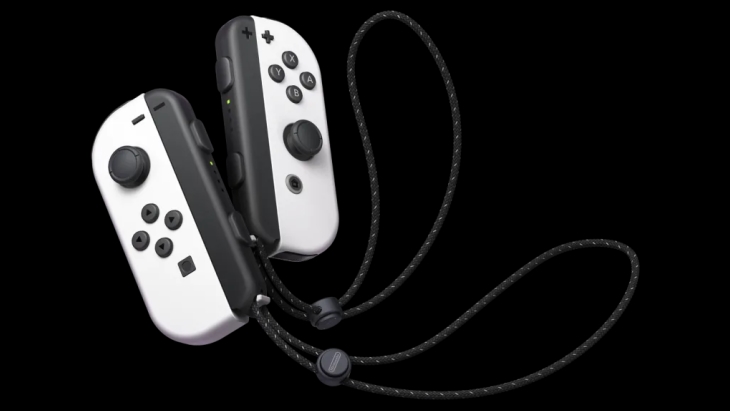
Nintendo have stated that the Nintendo Switch Joy-Con analog sticks have improved with every iteration; with the OLED Model having “all the improvements.”
The recent four-part Ask the Developer [1, 2, 3, 4] discussed the Nintendo Switch OLED Model. It featured Ko Shiota (Director, Executive Member of the Board Senior Executive Officer General Manager, Technology Development Division), and Toru Yamashita (Deputy General Manager, Technology Development Department).
Among the design and technical discussion, both were asked about the improvements that have come to the Nintendo Switch over time. Yamashita revealed that the Joy-Cons did have improvements to the analog sticks.
“Among others, the analog-stick parts have continuously been improved since launch, and we are still working on improvements.
The analog stick at first release cleared the Nintendo reliability test using the method of rotating the stick while continually applying a load to it, with the same criteria as the Wii U GamePad’s analog stick.
As we have always been trying to improve it as well, we have investigated the Joy-Con controllers used by the customers and repeatedly improved the wear resistance and durability.
The parts of the Joy-Con analog sticks are not something that can be bought off the shelf but are specially designed, so we have undergone a lot of considerations to improve them. In addition, we improved the reliability test itself, and we have continued to make changes to improve durability and clear this new test.”
The improvements were confirmed via testing, and were implemented into the Nintendo Switch Lite, with similar continual improvements to the Nintendo Switch Pro Controller. The Joy-Cons on the Nintendo Switch OLED Model were later confirmed to have the latest versions of of the analog stick, with all the improvements made.
Nonetheless, Nintendo may still be somewhat hedging their bets on the Joy-Con analog sticks’ durability. The Q&A asks both the developers “Do you mean that, basically, wear is unavoidable as long as the parts are physically in contact?” Shiota and Yamashita agreed.
“Shiota: Yes, for example car tires wear out as the car moves, as they are in constant friction with the ground to rotate. So with that same premise, we asked ourselves how we can improve durability, and not only that, but how can both operability and durability coexist? It’s something we are continuously tackling.
Yamashita: The degree of wear depends on factors like the combination of the materials and forms, so we continue to make improvements by researching which combinations are less likely to wear. We mentioned that the Joy-Con controller specifications hadn’t changed in the sense that we didn’t add new features such as new buttons, but the analog sticks in the Joy-Con controllers included with Nintendo Switch – OLED Model are the latest version with all the improvements. Needless to say, so are the analog sticks included in Nintendo Switch, Nintendo Switch Lite, separately sold Joy-Con controllers, and the Nintendo Switch Pro Controller that are currently being shipped.”
As previously reported, the Nintendo Switch’s Joy-Cons have issues with drifting–which is when the joystick remains untouched, yet input is still registered.
This resulted in a class action lawsuit by Chimicles, Schwartz Kriner, & Donaldson-Smith in July 2019. Reports suggest Nintendo even began repairing Joy-Cons for free mere days after the lawsuit became public knowledge.
The Nintendo Switch Lite was later added to the lawsuit, and the hardware failure causing the drift was exposed. Curiously, a Tencent representative (the distributor of the Nintendo Switch in China) told a customer that the drift was caused by playing an imported game.
In late December, 2019 we also reported how French consumer magazine 60 millions de consommateurs awarded Nintendo their “Golden Cactus” award (specifically the “Cactus of the Too Fragile Product”), which is given to products and services that cause the most frustration. Belgian consumer organization Testankoop also demanded Nintendo repair all Joy-Cons for free, and honor a two year warranty.
In May 2020, a federal judge in the U.S. District Court for the Northern District of Illinois ruled a lawsuit against Nintendo due to the Joy-Con drift must go to arbitration. In early October 2020, a mother and son sued Nintendo over the Joy-Con drift, asking for over $5,000,000 USD.
Nintendo President Shuntaro Furukawa reportedly apologized “for any inconvenience caused to our customers” due to the drift, during an investor Q&A in June 2020. Since July 2019, Nintendo have been repairing Joy-cons even outside of users’ warranties.
A collective of European consumers’ associations announced in early December 2020 that they were investigating the infamous Joy-Con drift defect. As part of the European Green Deal (“promoting policy to make consumer products more sustainable”) curbing issues with durability, repairability, and tackling products that fail sooner than expected are “high on the agenda.”
Most recently, in January of this year, Canadian law firm Lambert Avocat Inc. announced they started a class action lawsuit for those in Québec affected by the Nintendo Switch Joy-Con drift defect.
Image: Nintendo